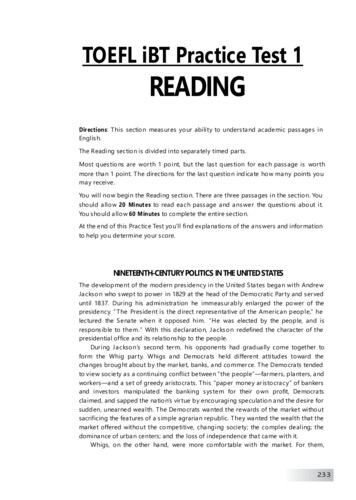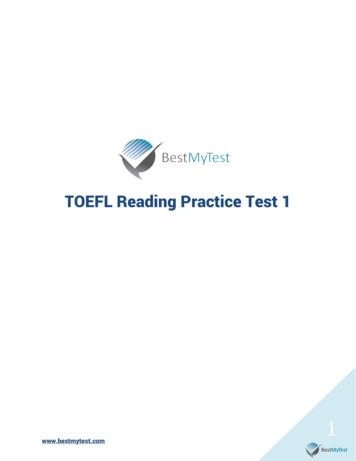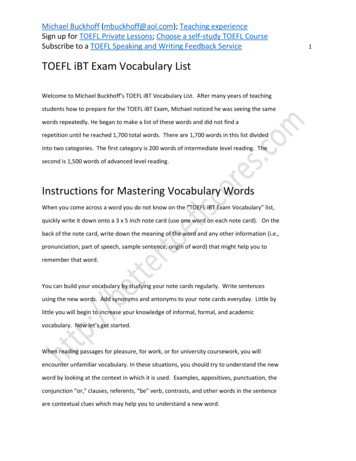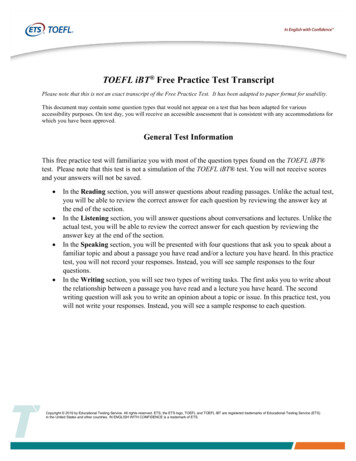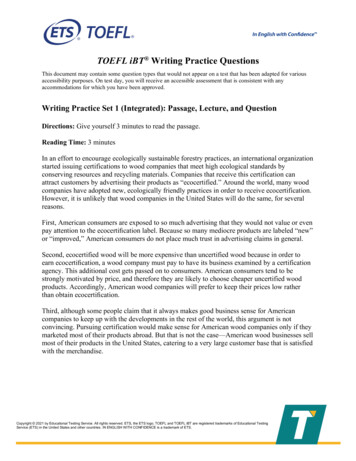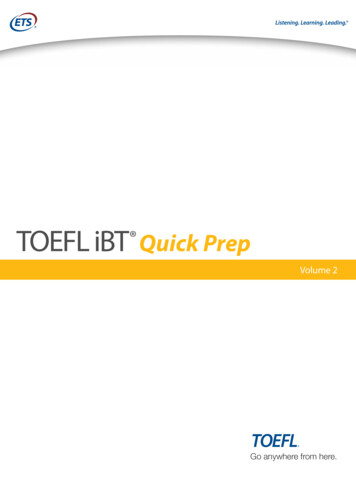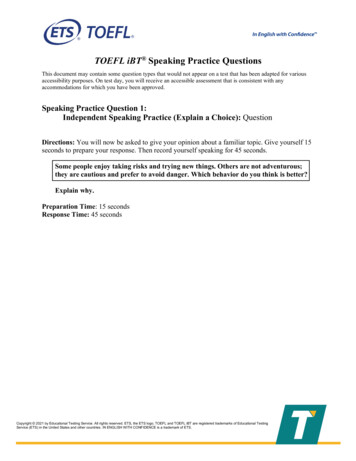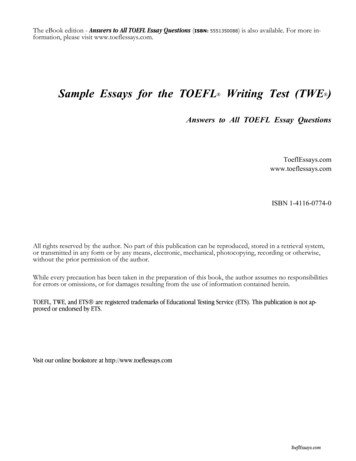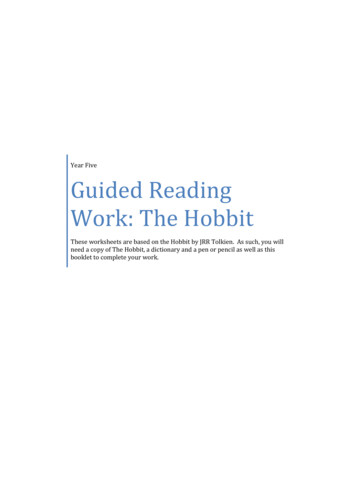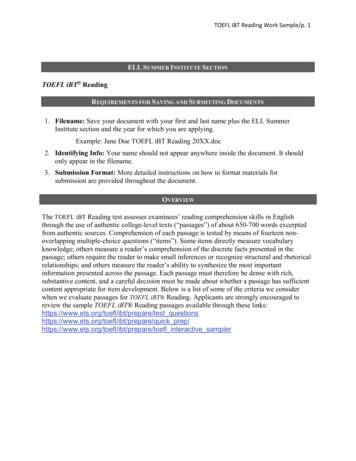
Transcription
TOEFL iBT Reading Work Sample/p. 1ELL SUMMER INSTITUTE SECTIONTOEFL iBT ReadingREQUIREMENTS FOR SAVING AND SUBMITTING DOCUMENTS1. Filename: Save your document with your first and last name plus the ELL SummerInstitute section and the year for which you are applying.Example: Jane Doe TOEFL iBT Reading 20XX.doc2. Identifying Info: Your name should not appear anywhere inside the document. It shouldonly appear in the filename.3. Submission Format: More detailed instructions on how to format materials forsubmission are provided throughout the document.OVERVIEWThe TOEFL iBT Reading test assesses examinees’ reading comprehension skills in Englishthrough the use of authentic college-level texts (“passages”) of about 650-700 words excerptedfrom authentic sources. Comprehension of each passage is tested by means of fourteen nonoverlapping multiple-choice questions (“items”). Some items directly measure vocabularyknowledge; others measure a reader’s comprehension of the discrete facts presented in thepassage; others require the reader to make small inferences or recognize structural and rhetoricalrelationships; and others measure the reader’s ability to synthesize the most importantinformation presented across the passage. Each passage must therefore be dense with rich,substantive content, and a careful decision must be made about whether a passage has sufficientcontent appropriate for item development. Below is a list of some of the criteria we considerwhen we evaluate passages for TOEFL iBT Reading. Applicants are strongly encouraged toreview the sample TOEFL iBT Reading passages available through these links:https://www.ets.org/toefl/ibt/prepare/test ck prep/https://www.ets.org/toefl/ibt/prepare/toefl interactive sampler
TOEFL iBT Reading Work Sample/p. 2PASSAGE EVALUATION CRITERIA Language and accessibility. Language should be introductory college-level andacademic in tone. Passage should not assume a North American audience. Main ideas. A good passage is conceptually complex enough that it cannot besummarized adequately in a single sentence. Instead, it should contain three or moredistinct main ideas that a proficient reader can identify. Complexity of content. Presentation of information should go beyond the encyclopediclisting of facts. Content should consist of multiple layers of information, ranging fromgeneral ideas to specific details, examples, and explanations that support these ideas. Inaddition, a good passage will employ a variety of techniques to develop the ideaspresented. These might include analysis of cause/ effect relating to a phenomenon (dinosaur extinction was caused bymeteorite impact) comparison/ contrast (the reproductive strategies of "opportunists" vs. those of"competitors") advantages/ disadvantages (e.g., of an organism’s adaptive mechanisms) evidence/counterevidence (X suggests that Theory A is true, but Y suggests that it isnot) assertion/qualification (Fish are water-breathing animals, although a few have alsoevolved to breathe surface air). Degree of technicality. To avoid favoring specialists in a given subject, passages shouldnot be overly technical. A reader proficient in English should be able to understand apassage based on its content alone. Test takers should not have to rely on outsideknowledge (of biology or chemistry, for instance) beyond what is expected of a typicalhigh school student. Other potential content issues. Repetition? A good passage contains little or noredundancy. We have to create 14 items based on 700 words, so passages must not repeatinformation. Excessive examples? We like passages that provide an occasional exampleto support an idea; a passage that consists largely of examples of a single phenomenondoes not work. Common knowledge? A passage should not contain excessive commonknowledge or information that a reader might infer through common sense. Test items arebased on passage content, and test takers should be able to answer them only on the basisof knowledge gained by reading the passage. Visualization required? Physicaldescription should not be so detailed that a reader must rely on visualization skills tounderstand the content. Abstraction? Content should be concrete enough to be testable. Apassage that is largely abstract in nature will not work.
TOEFL iBT Reading Work Sample/p. 3PASSAGE EXCERPTS WITH COMMENTSBelow are two excerpts from passages that were actually submitted to TOEFL iBT Readingtogether with some comments on their problematic features. These passages were not accepted.Please look closely at the excerpts and at the comments provided. This should help you to forman idea of how we evaluate passages.Example 1:The supercooling point (temperature of crystallization) of a liquid is the temperature atwhich it turns to ice. Although 0 C is ordinarily considered the freezing point of water, insectfluids and cell contents may not freeze down to -20 C or lower because of cryoprotectants thatreduce the supercooling temperature. Glucose, trehalose, low-molecular-weight lipids, andsorbitol in the hemolymph act as cryoprotectants. No natural chemical, however, equals glycerolto prevent freezing. Glycerol has been found in most overwintering, freezing-tolerant insects,especially larvae and pupae. Glycerol extends the temperature range of supercooling withoutfreezing to retard the rate of freezing and to reduce the size of crystals. Both actions reducefreezing injury to tissues. When the insect is indeed frozen, glycerol presumably reduces thedeleterious osmotic effects and prevents the intracellular freezing that is fatal.A second strategy that insects use to avoid freezing injury is to avoid having icenucleation centers (nucleators) that accelerate ice formation. Mineral particles, and especiallybacteria, act as catalysts for ice formation. The presence of nucleators in the gut or hemolymphof an insect raises the supercooling point. On the other hand, the addition of dissolved substancesin water lowers the points of freezing and supercooling. Even without special antifreezesubstances, the body fluids of overwintering insects can often be supercooled to -20 C. Thusmany insects survive subzero weather by evacuating their guts in autumn and supercoolingwithout harm, to temperatures above the supercooling point. When the supercooling point of theinsect is reached, an ice crystal will form internally around a nucleator.Comments: Many technical terms (supercooling, cryoprotectants, hemolymph, intracellular, etc.).Note that even though some terms are defined (supercooling), the definition contains yetanother difficult term (crystallization). Difficult language level even aside from technical terms (the deleterious osmotic effects) Lots of detailed mechanistic description (steps in the freezing process) Many discrete facts without the development of argumentsExample 2:When paint on the surface of a canvas appears thick and somewhat three-dimensional, itis called impasto. Van Gogh often applied paint in an impasto manner in order to express hisintense feelings directly on the canvas. In his impatience, he sometimes used paint squeezeddirectly from the tube. Artists have also used their palette knife to spread thick paint on thesupport for an impasto effect.Another oil painting technique involving thickish paint is called scumbling. In scumbling,the artist drags brushstrokes of paint over the dry layer of paint underneath, as Joan Mitchell did
TOEFL iBT Reading Work Sample/p. 4on her canvas Marlin. Scumbling creates an open-textured brushstroke of opaque paint that stilllets the color underneath appear. Usually, a light color is color is scumbled over a dark oneunderneath.Comments: List of loosely connected facts, i.e. encyclopedic Lots of specialized language (palette knife, brushstrokes, canvas) Too many definitions (impasto, scumbling) Visualization skills required (second paragraph’s description of base layer of paint visiblethrough top layer) Too many examplesWORK SAMPLE TASKS AND SOURCE MATERIALSReading—Task 1Mini Passage ReviewWith the above criteria in mind, please assess the two sample passages included below forsuitability as potential TOEFL iBT Reading Comprehension passages and explain yourdecisions in terms of these criteria. Your responses will be evaluated on the basis of your abilityto apply our criteria to a potential passage. Your comments for EACH passage should be aMAXIMUM of 150 words in length, single-spaced in 11 point Calibri. Please be as concise aspossible. Comment on a passage’s perceived strengths and weaknesses, using the checklist belowand referring to specific details from the passage to illustrate your comments.Checklist: Language and accessibilityMain ideasComplexity of contentDegree of technicalityOther potential content issuesSample Passage #1The Lure of the American WestThe Homestead Act of 1862, passed during the Civil War by a Congress free of southernopposition, reflected the ideals and goals of a Republican United States. In keeping with theJeffersonian vision of a nation of small farmers, the federal government sought to extend thesystem of individual land ownership west. The Homestead Act, expanding the basic system ofsettlement established by the Ordinance of 1785, provided a means for privatizing expansivewestern public lands. Before the Civil War homesteading west of the Mississippi River hadproved problematic for individual families, as cheap lands intended for individuals quicklyevolved into a commercialized system of land speculation.The Homestead Act provided title to 160-acre parcels for individuals who made“improvements” to the land over a period of five years. Settlers had the option to purchase the
TOEFL iBT Reading Work Sample/p. 5land for 1.25 per acre after the first six months of residency, and some opted to pay up front tosecure mortgages to fund improvements. This option encouraged speculation by allowinghomesteaded land to be brought into the commercial market a quarter section (one quarter of asquare mile) at a time at a higher resale value. Rather than improving the land, homesteadersoften sold out to other individuals or commercial farms that grew grain crops over vast acreages.For those homesteading west of Dodge City, Kansas, on the 100th meridian (thegeographic line of aridity where annual rainfalls drop below 8 inches per year), 160 acresrequired expensive irrigation works for farming or other dry-land farming techniques. Theseparcels were also far too small for ranching. In addition, five years was too long to develop theland without the benefit of ownership and access to loans. Congress addressed these problems in1877 with the Desert Lands Act. The act, applicable in eleven western states, allowed forhomesteading on 640-acre parcels of arid land at 25 cents per acre and provided title within threeyears for a dollar an acre for settled, irrigated, land. However, there was no official definition ofhow much land and water constituted irrigated cultivation. For much of the desert West,agriculture required massive federal support that came with the creation of the ReclamationService in 1902. The renamed Bureau of Reclamation (BOR) eventually funded extensiveirrigation projects in 16 western states. The simple act of providing land and water to farmersand ranchers enormously expanded the growth and reach of the federal government.It is hard to underestimate the power of perception in the creation of the West as both ageographical region and an ideal with lasting global appeal. In 1895 future president WoodrowWilson wrote, “The West has been the great word of our history. The Westerner has been thetype and master of our American life.” The “great word” was always more myth than truth, notentirely false but a powerful idea with enough fact to motivate millions to move great distancesand suffer enormous hardship. The mythic version of the western story is still celebrated inliterature, on film, and on TV. But the myth had a dark side. It justified the mistreatment ofIndians and their ancestral environment and contributed to class and racial conflict thatcharacterized the post-Civil War West.At the heart of the mythic story of the West was a question: was the West the land ofunlimited opportunity or a paradise lost? Promoters and “boosters” lured settlers, workers, andinvestors to the region by steadfastly portraying the West as a paradise to be tamed and civilized.Western boosters were masters of public relations and emerging techniques of advertising. Usingall of the new mass media at their disposal—dime novels, traveling shows, posters, pamphlets,newspapers, graphic art, and photography—they promoted places that did not yet exist andinvented simple solutions to complex cultural and environmental dilemmas. Boosters dismissedthe lack of water in much of the region with claims like, “The rain follows the plow.” The faiththat ingenuity, technology, and hard work could transform even the wealth was widespread andpushed global migrations to the West.Word Count: 680
TOEFL iBT Reading Work Sample/p. 6Sample Passage #2Water and the Birth of the Solar SystemWater was important in the formation of our solar system, especially for the ‘gas giant’and ‘ice giant’ planets beyond Mars. Star systems form in the clouds of gas, mineral dust, andwater drifting through space. A portion of the cloud may separate and collapse under its ownweight, sometimes as the result of a massive, nearby exploding star (supernova), as happenedwith our own Sun. The clues to this trigger event lie within ancient meteorites that have fossilchemical traces of short-lived, highly radioactive isotopes that could only have been generated ina supernova that erupted just prior to our own solar system forming.As the portion of cloud begins to collapse, any initial movement is converted into a slowrotation of the cloud. As the cloud continues to shrink, it begins to rotat
Passage should not assume a North American audience. Mainideas. A good passage is conceptually complex enough that it cannot be summarized adequatelyin a single sentence. Instead, it should contain three or more distinct main ideas that a proficient reader can identify. Complexity of content. Presentation of information should go beyond the encyclopedic listing of facts. Content should consist .

